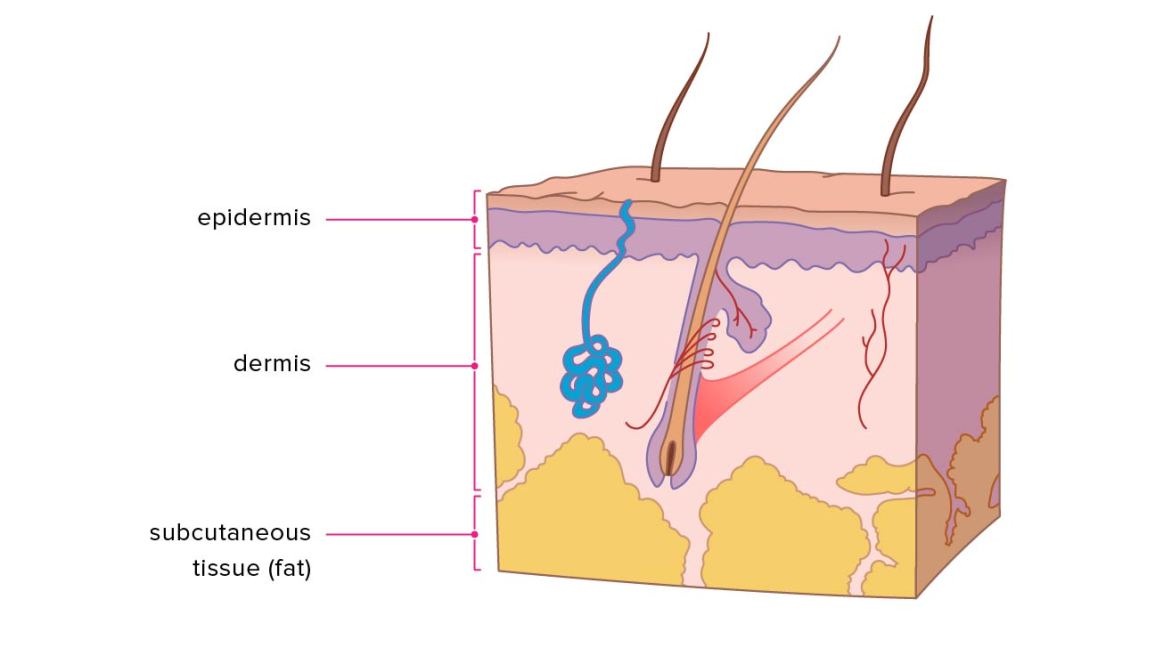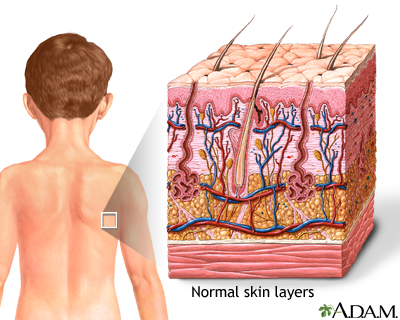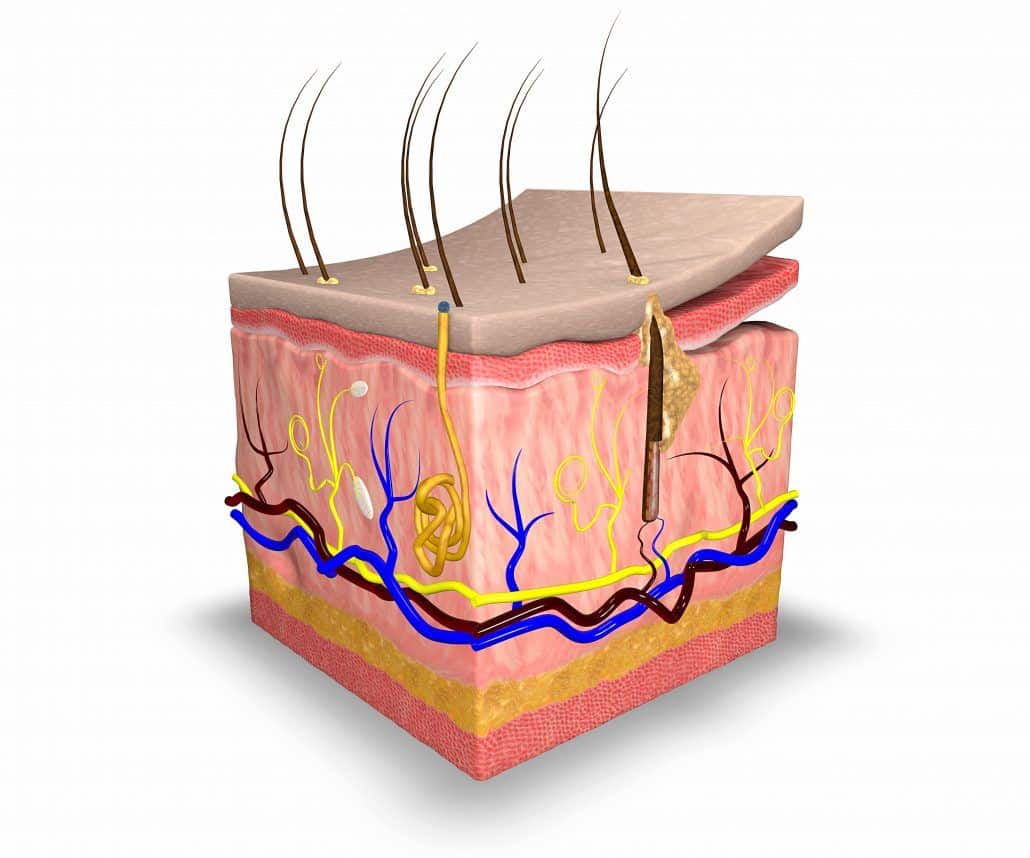This is named for its fingerlike projections called papillae that extend toward the epidermis. Arch Gerontol Geriatr. The epidermis, "epi" coming from the Greek language meaning "over" or "upon", is the outermost layer of the skin. Brown TM, Krishnamurthy K. The exocrine functions of the skin are by way of the sweat and sebaceous glands. Progress in Biophysics and Molecular Biology. Skin hydration and lifestyle-related factors in community-dwelling older people. PMC These cells are the mesenchymal origin, derived from CD34 positive stem cells of bone marrow and are part of the mononuclear phagocytic system. Cells of the Epidermis Keratinocytes. There are fewer than genes that are specific for the skin, and these are expressed in the epidermis.


Give feedback about this page. The free nerve endings extend into the epidermis and sense pain, heat, and cold. Anatomical terminology [ edit on Wikidata ]. Archived from the original on 27 February The hypodermis is deep to the dermis and is also called subcutaneous fascia.
StatPearls [Internet].
International Journal of Cosmetic Science. Another important function of the skin is body temperature regulation. The toxins can be fatal to most vertebrates or have no effect against others. Main article: Skin flora. Papillary and reticular layer. The word skin originally only referred to dressed and tanned animal hide and the usual word for human skin was hide. For example, your head contains more hair follicles than anywhere else. Areas that highlight higher amounts of UVR reflect darker-skinned populations, generally located nearer towards the equator. Give feedback about this page. Nanoparticles along with multi-modal imaging techniques have been used as a way to diagnose cancer non-invasively. It consists of loose connective tissue, adipose tissue and elastin. It covers the entire body. Mucous and granular glands are both divided into three different sections which all connect to structure the gland as a whole.
Skin explained - Better Health Channel
- Japanese Journal of Health Physics.
- Each season requires suitable clothing in order to facilitate the evaporation Skin the sweat.
- The density of skin flora depends on region of the skin.
Skin is the layer of usually soft, flexible outer tissue covering the body of a vertebrate animal, with three main functions: protection, regulation, and sensation. Other animal coverings , such as the arthropod exoskeleton , have different developmental origin , structure and chemical composition. The adjective cutaneous means "of the skin" from Latin cutis 'skin'. In mammals , the skin is an organ of the integumentary system made up of multiple layers of ectodermal tissue and guards the underlying muscles , bones , ligaments , and internal organs. Skin of a different nature exists in amphibians , reptiles , and birds. All mammals have some hair on their skin, even marine mammals like whales , dolphins , and porpoises that appear to be hairless. The skin interfaces with the environment and is the first line of defense from external factors. For example, the skin plays a key role in protecting the body against pathogens [3] and excessive water loss. Severely damaged skin may heal by forming scar tissue. This is sometimes discoloured and depigmented. The thickness of skin also varies from location to location on an organism. In humans, for example, the skin located under the eyes and around the eyelids is the thinnest skin on the body at 0. The skin on the palms and the soles of the feet is the thickest skin on the body at 4 mm thick. The speed and quality of wound healing in skin is promoted by estrogen. Fur is dense hair. On some animals, the skin is very hard and thick and can be processed to create leather. Reptiles and most fish have hard protective scales on their skin for protection, and birds have hard feathers , all made of tough beta-keratins.
Official websites use. Share sensitive information only on official, secure websites. The skin is the largest organ Skin the body. The skin and its derivatives hair, Skin, nails, sweat and oil glands make up the integumentary system. One of the main functions Skin the skin is protection. It protects the body from external factors such as bacteria, chemicals, and temperature.



Skin. Skin explained
The skin is the largest organ of the human body. It is soft, to allow movement, but still tough enough to resist breaking or tearing, Skin. It varies in texture and thickness from one part of the body to the next. For instance, the skin on our lips and eyelids is very thin and delicate, while skin on the Skin of our feet is thicker and harder. Our skin is a good indicator of our general health. If someone is sick, it often shows in Skin skin. The skin you can see is called the epidermis. This protects the more delicate inner layers. The bottom sheet is where new epidermal cells are made. As old, dead skin cells are sloughed off the surface, Skin, new ones are pushed up to replace them. The epidermis also contains melanin, the pigment that gives skin its colour. Under the epidermis is the Skin. This Skin made up of elastic pieluchy super seni 1 elastin for suppleness and protein fibres collagen for strength, Skin. The dermis contains sweat glands, Skin, sebaceous glands, Skin, hair follicles, blood vessels and nerves.
Related Links
Click Image to Enlarge. The skin is the body's largest organ. It covers the entire body. It serves as a protective shield against heat, light, injury, and infection.
Cutaneous reflex in human locomotion Cutaneous respiration — gas exchange conducted through skin Moult Role of skin Skin locomotion Skinning.


Yes you the talented person